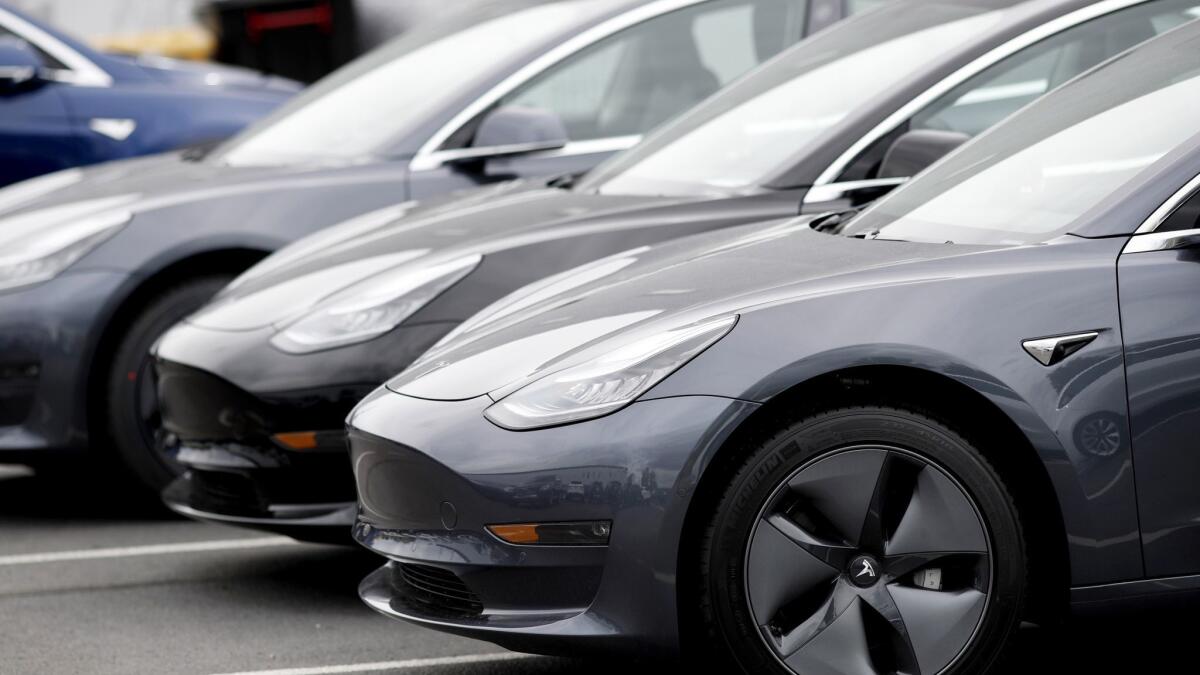Tesla beats expectations, delivers 95,000 vehicles in the second quarter

- Share via
Tesla Inc. delivered 95,200 vehicles to customers in the second quarter, outperforming analysts’ expectations.
Analysts polled by FactSet expected the company to deliver 91,000 vehicles in the second quarter. The Palo Alto electric-car maker said Tuesday that it delivered 77,550 Model 3 cars, and a combined 17,650 Model S sedans and Model X sport utility vehicles.
The news boosted Tesla’s share price 7% to $241 in after-hours trading.
Tesla produced a total of 87,048 vehicles, including 72,531 Model 3 cars and 14,517 Model S and Model X vehicles. During the first quarter of the year, Tesla produced about 77,100 total vehicles — 62,950 Model 3s and 14,150 Model S and Model X vehicles.
Tesla described its quarterly delivery and production totals as “record” numbers and said it had more than 7,400 vehicles in transit to customers at the end of the quarter. The company said orders placed during the second quarter “exceeded” its deliveries, meaning Tesla is entering the third quarter with an increase in its order backlog.
Dan Ives, managing director of Wedbush Securities, called Tesla’s second-quarter delivery numbers a “major step in the right direction” after the company’s first-quarter “debacle,” in which Tesla delivered 63,000 vehicles to customers — a 31% drop from the previous quarter.
Although the result “alleviates near-term demand concerns,” Ives said all eyes will be on that trajectory going forward.
Deliveries were higher than the previous quarter, but second-quarter financial losses could still be deep. The company will release financial results sometime over the next several weeks. Chief Executive Elon Musk has warned investors not to expect a profit this time around.
The crowd-sourced, social media swarm that is betting Tesla will crash and burn »
Another quarter of losses would raise questions about Tesla’s ability to transform itself into a profit-making enterprise. After 16 years, the company has never posted an annual profit. It listed a quarterly profit only a few times, including back-to-back quarters in 2018.
During the fourth quarter of last year, Tesla earned $139 million on sales of 90,966 cars.
Since then, the company has lowered car prices several times, further crimping profit margins. And the company is now counting on increased sales of the lower-priced Model 3, effectively replacing higher-profit margin Model S sedans or Model X SUVs.
Tesla has said it intends to continue cutting costs and growing sales to move itself into the black. Updated versions of the Model S and Model X, with longer range and new suspensions, could arrest the falling demand for those vehicles.
Musk has told Wall Street analysts to expect 360,000 to 400,000 deliveries this year. For Tesla to reach 360,000 deliveries for the full year, it will have to sell 201,800 cars in the next two quarters.
One of the head winds Tesla is fighting is declining federal tax subsidies for its electric vehicles. Starting July 1, the federal tax credit will be $1,875, down from $3,750. A previous cut in the subsidy amount in January, from $7,500, dragged down sales and profits in Tesla’s first quarter.
The federal subsidy program was created to kick-start electric vehicle demand, but it winds down after a manufacturer reaches certain sales levels. Competing electric-vehicle makers, including Jaguar, Audi, BMW and Porsche, can offer the full $7,500, putting more competitive pressure on Tesla. At year’s end, federal subsidies for Tesla buyers will disappear unless Congress votes to renew them. Californians can still get an electric vehicle rebate from the state.
“Right now, it’s all about second-half numbers and profitability,” Ives said. “If they can hit those numbers, that’s going to be the key as they continue to have an Everest-like challenge showing sustainability of demand. That is really what the Street is focused on going forward.”
The public thinks Tesla’s Autopilot is safer than it is, an insurance group says »
Rather than focus on pumping out cars, some analysts wish Musk and Tesla would fix logistics and delivery problems. Doing so would resolve questions about actual level of annual demand.
Tesla faces “gradual brand destruction” by failing to fix those problems, as well as complaints about its service operations, Cowen stock analyst Jeffrey Osborne said in a note to investors last week. Musk has not laid out an operations repair plan, which would be “more valuable to the company’s long-term growth than shipping a few extra thousands of vehicles in a quarter,” he said.
Tesla said Tuesday it made “significant progress streamlining our global logistics and delivery operations at higher volumes, enabling cost efficiencies and improvements to our working capital position.”
Musk has previously talked about improving service operations, saying at a shareholder meeting last month that Tesla has mobile service vans that it used on a trial basis in the San Francisco Bay Area and has since extended to the Los Angeles area, among other areas, for tire repairs.








